Impact of Staff Motivation Schemes on Employee Retention
VerifiedAdded on 2023/06/05
|11
|3491
|393
AI Summary
This research aims to analyze the impact of staff motivation schemes on employee retention, with a case study on Sainsbury. The study will cover the concept of staff motivation, employee retention, impact of staff motivational scheme on employee retention, and challenges faced during implementing the staff motivational scheme within the organization.
Contribute Materials
Your contribution can guide someone’s learning journey. Share your
documents today.
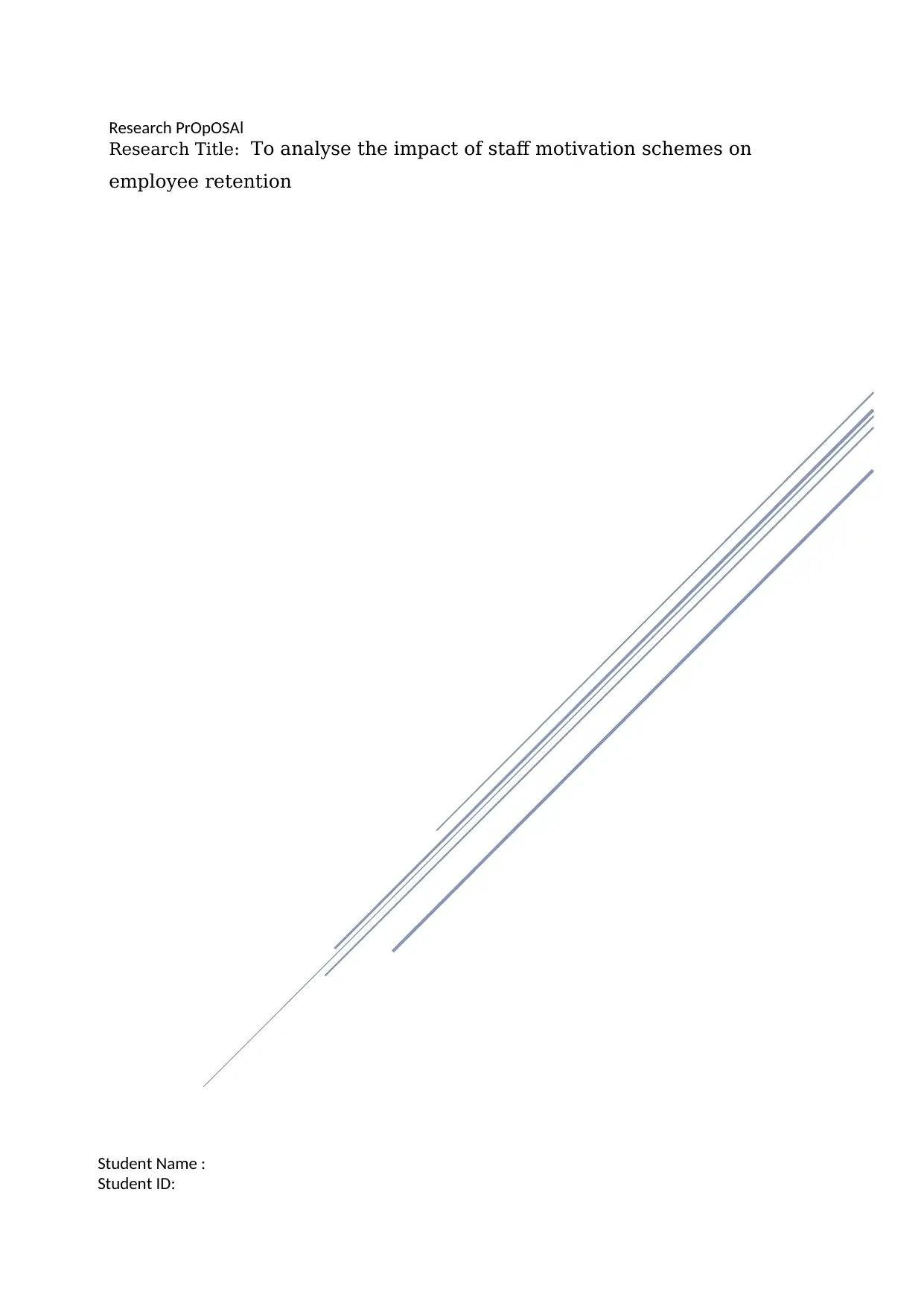
Student Name :
Student ID:
Research PrOpOSAl
Research Title: To analyse the impact of staff motivation schemes on
employee retention
Student ID:
Research PrOpOSAl
Research Title: To analyse the impact of staff motivation schemes on
employee retention
Secure Best Marks with AI Grader
Need help grading? Try our AI Grader for instant feedback on your assignments.
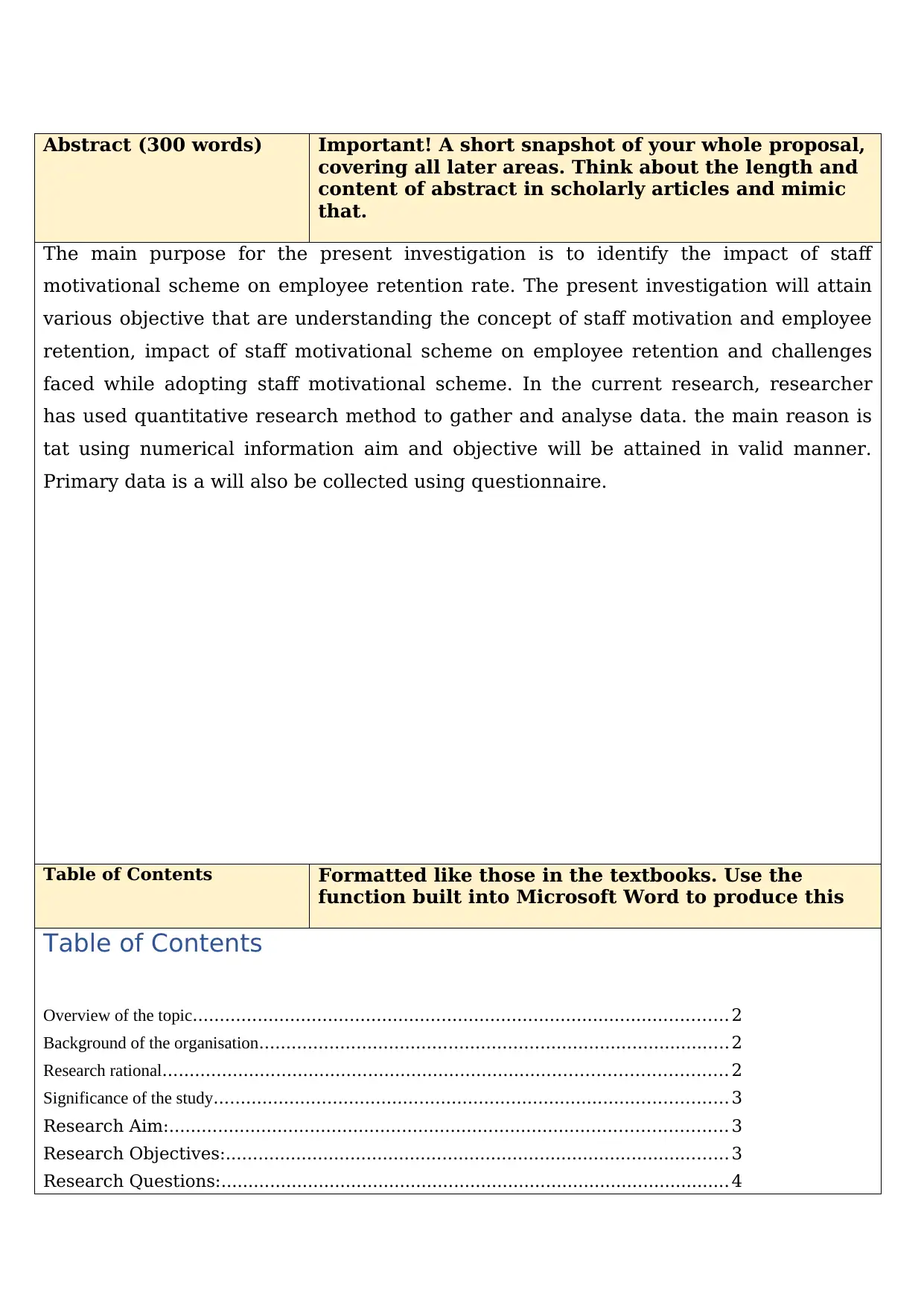
Abstract (300 words) Important! A short snapshot of your whole proposal,
covering all later areas. Think about the length and
content of abstract in scholarly articles and mimic
that.
The main purpose for the present investigation is to identify the impact of staff
motivational scheme on employee retention rate. The present investigation will attain
various objective that are understanding the concept of staff motivation and employee
retention, impact of staff motivational scheme on employee retention and challenges
faced while adopting staff motivational scheme. In the current research, researcher
has used quantitative research method to gather and analyse data. the main reason is
tat using numerical information aim and objective will be attained in valid manner.
Primary data is a will also be collected using questionnaire.
Table of Contents Formatted like those in the textbooks. Use the
function built into Microsoft Word to produce this
Table of Contents
Overview of the topic................................................................................................... 2
Background of the organisation....................................................................................... 2
Research rational........................................................................................................ 2
Significance of the study............................................................................................... 3
Research Aim:....................................................................................................... 3
Research Objectives:............................................................................................. 3
Research Questions:.............................................................................................. 4
covering all later areas. Think about the length and
content of abstract in scholarly articles and mimic
that.
The main purpose for the present investigation is to identify the impact of staff
motivational scheme on employee retention rate. The present investigation will attain
various objective that are understanding the concept of staff motivation and employee
retention, impact of staff motivational scheme on employee retention and challenges
faced while adopting staff motivational scheme. In the current research, researcher
has used quantitative research method to gather and analyse data. the main reason is
tat using numerical information aim and objective will be attained in valid manner.
Primary data is a will also be collected using questionnaire.
Table of Contents Formatted like those in the textbooks. Use the
function built into Microsoft Word to produce this
Table of Contents
Overview of the topic................................................................................................... 2
Background of the organisation....................................................................................... 2
Research rational........................................................................................................ 2
Significance of the study............................................................................................... 3
Research Aim:....................................................................................................... 3
Research Objectives:............................................................................................. 3
Research Questions:.............................................................................................. 4
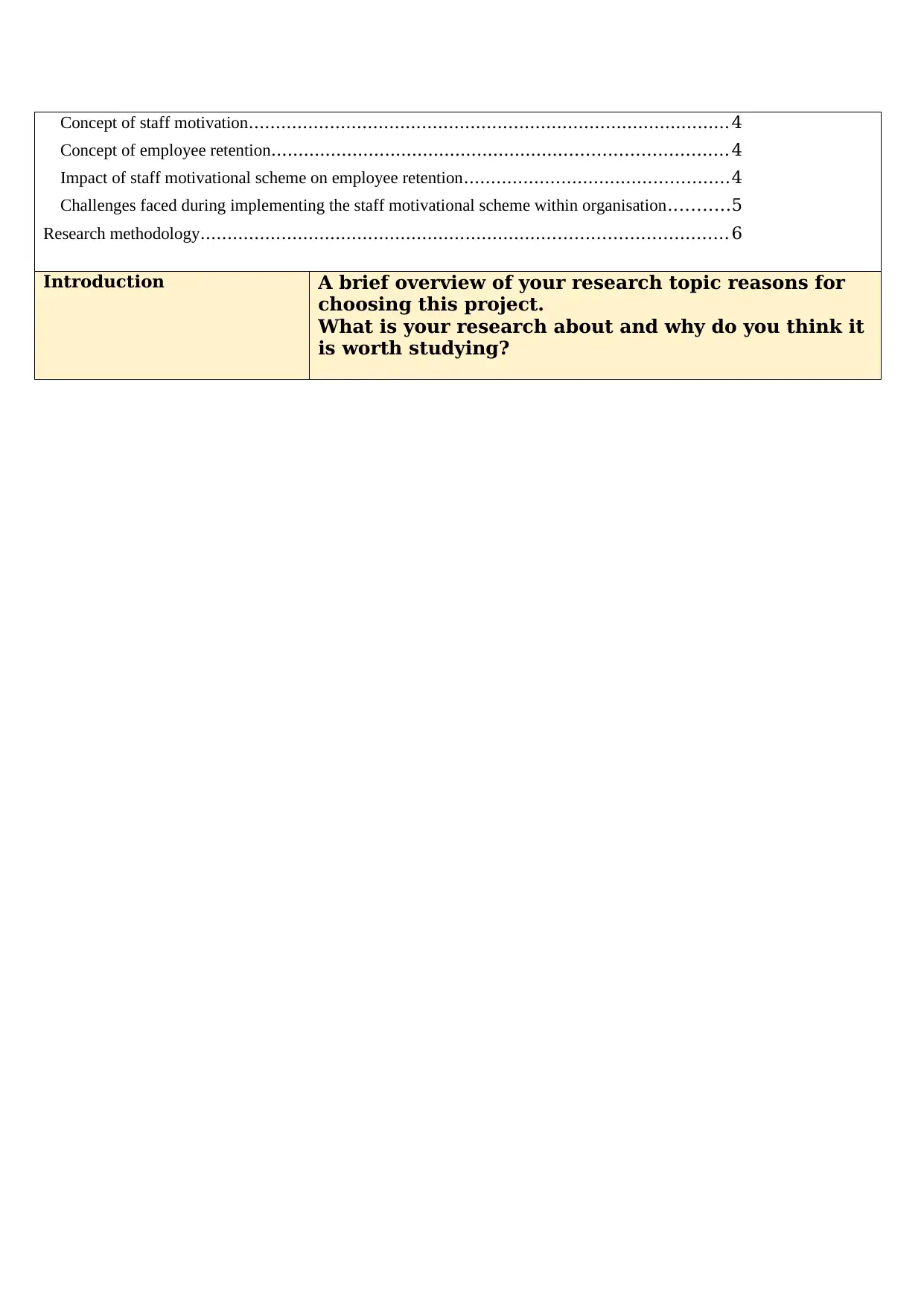
Concept of staff motivation......................................................................................... 4
Concept of employee retention.................................................................................... 4
Impact of staff motivational scheme on employee retention.................................................4
Challenges faced during implementing the staff motivational scheme within organisation...........5
Research methodology................................................................................................. 6
Introduction A brief overview of your research topic reasons for
choosing this project.
What is your research about and why do you think it
is worth studying?
Concept of employee retention.................................................................................... 4
Impact of staff motivational scheme on employee retention.................................................4
Challenges faced during implementing the staff motivational scheme within organisation...........5
Research methodology................................................................................................. 6
Introduction A brief overview of your research topic reasons for
choosing this project.
What is your research about and why do you think it
is worth studying?
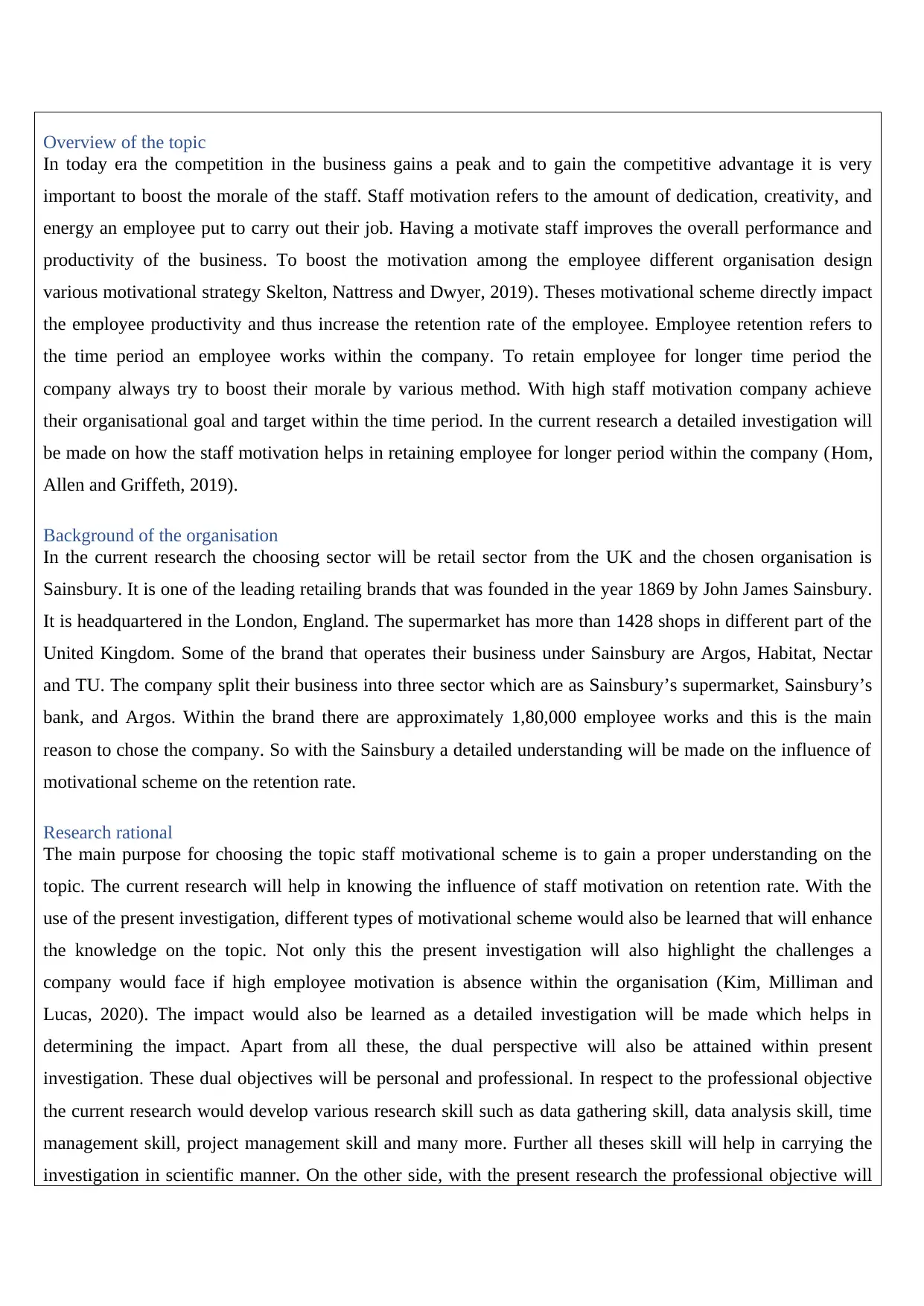
Overview of the topic
In today era the competition in the business gains a peak and to gain the competitive advantage it is very
important to boost the morale of the staff. Staff motivation refers to the amount of dedication, creativity, and
energy an employee put to carry out their job. Having a motivate staff improves the overall performance and
productivity of the business. To boost the motivation among the employee different organisation design
various motivational strategy Skelton, Nattress and Dwyer, 2019). Theses motivational scheme directly impact
the employee productivity and thus increase the retention rate of the employee. Employee retention refers to
the time period an employee works within the company. To retain employee for longer time period the
company always try to boost their morale by various method. With high staff motivation company achieve
their organisational goal and target within the time period. In the current research a detailed investigation will
be made on how the staff motivation helps in retaining employee for longer period within the company (Hom,
Allen and Griffeth, 2019).
Background of the organisation
In the current research the choosing sector will be retail sector from the UK and the chosen organisation is
Sainsbury. It is one of the leading retailing brands that was founded in the year 1869 by John James Sainsbury.
It is headquartered in the London, England. The supermarket has more than 1428 shops in different part of the
United Kingdom. Some of the brand that operates their business under Sainsbury are Argos, Habitat, Nectar
and TU. The company split their business into three sector which are as Sainsbury’s supermarket, Sainsbury’s
bank, and Argos. Within the brand there are approximately 1,80,000 employee works and this is the main
reason to chose the company. So with the Sainsbury a detailed understanding will be made on the influence of
motivational scheme on the retention rate.
Research rational
The main purpose for choosing the topic staff motivational scheme is to gain a proper understanding on the
topic. The current research will help in knowing the influence of staff motivation on retention rate. With the
use of the present investigation, different types of motivational scheme would also be learned that will enhance
the knowledge on the topic. Not only this the present investigation will also highlight the challenges a
company would face if high employee motivation is absence within the organisation (Kim, Milliman and
Lucas, 2020). The impact would also be learned as a detailed investigation will be made which helps in
determining the impact. Apart from all these, the dual perspective will also be attained within present
investigation. These dual objectives will be personal and professional. In respect to the professional objective
the current research would develop various research skill such as data gathering skill, data analysis skill, time
management skill, project management skill and many more. Further all theses skill will help in carrying the
investigation in scientific manner. On the other side, with the present research the professional objective will
In today era the competition in the business gains a peak and to gain the competitive advantage it is very
important to boost the morale of the staff. Staff motivation refers to the amount of dedication, creativity, and
energy an employee put to carry out their job. Having a motivate staff improves the overall performance and
productivity of the business. To boost the motivation among the employee different organisation design
various motivational strategy Skelton, Nattress and Dwyer, 2019). Theses motivational scheme directly impact
the employee productivity and thus increase the retention rate of the employee. Employee retention refers to
the time period an employee works within the company. To retain employee for longer time period the
company always try to boost their morale by various method. With high staff motivation company achieve
their organisational goal and target within the time period. In the current research a detailed investigation will
be made on how the staff motivation helps in retaining employee for longer period within the company (Hom,
Allen and Griffeth, 2019).
Background of the organisation
In the current research the choosing sector will be retail sector from the UK and the chosen organisation is
Sainsbury. It is one of the leading retailing brands that was founded in the year 1869 by John James Sainsbury.
It is headquartered in the London, England. The supermarket has more than 1428 shops in different part of the
United Kingdom. Some of the brand that operates their business under Sainsbury are Argos, Habitat, Nectar
and TU. The company split their business into three sector which are as Sainsbury’s supermarket, Sainsbury’s
bank, and Argos. Within the brand there are approximately 1,80,000 employee works and this is the main
reason to chose the company. So with the Sainsbury a detailed understanding will be made on the influence of
motivational scheme on the retention rate.
Research rational
The main purpose for choosing the topic staff motivational scheme is to gain a proper understanding on the
topic. The current research will help in knowing the influence of staff motivation on retention rate. With the
use of the present investigation, different types of motivational scheme would also be learned that will enhance
the knowledge on the topic. Not only this the present investigation will also highlight the challenges a
company would face if high employee motivation is absence within the organisation (Kim, Milliman and
Lucas, 2020). The impact would also be learned as a detailed investigation will be made which helps in
determining the impact. Apart from all these, the dual perspective will also be attained within present
investigation. These dual objectives will be personal and professional. In respect to the professional objective
the current research would develop various research skill such as data gathering skill, data analysis skill, time
management skill, project management skill and many more. Further all theses skill will help in carrying the
investigation in scientific manner. On the other side, with the present research the professional objective will
Secure Best Marks with AI Grader
Need help grading? Try our AI Grader for instant feedback on your assignments.
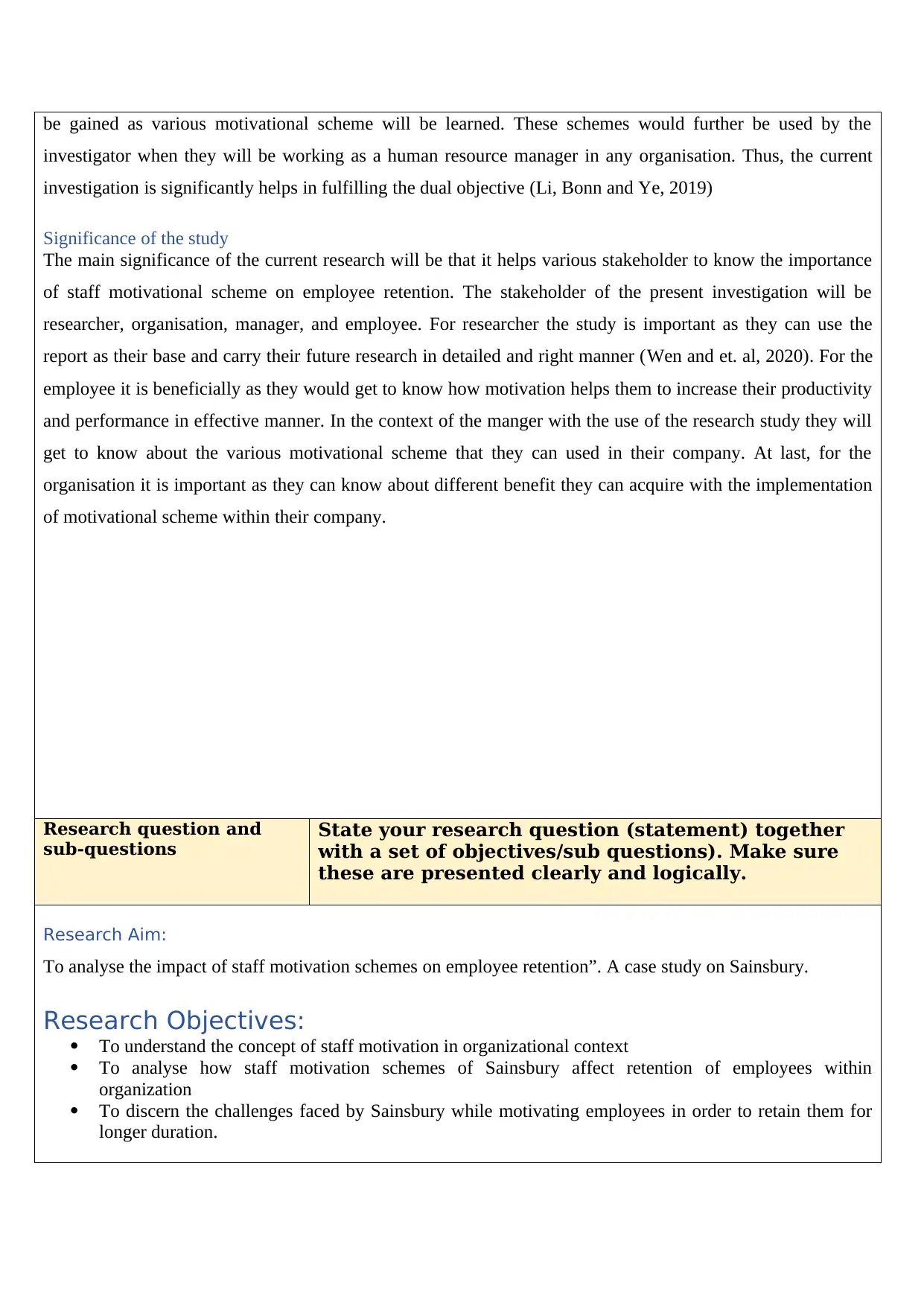
be gained as various motivational scheme will be learned. These schemes would further be used by the
investigator when they will be working as a human resource manager in any organisation. Thus, the current
investigation is significantly helps in fulfilling the dual objective (Li, Bonn and Ye, 2019)
Significance of the study
The main significance of the current research will be that it helps various stakeholder to know the importance
of staff motivational scheme on employee retention. The stakeholder of the present investigation will be
researcher, organisation, manager, and employee. For researcher the study is important as they can use the
report as their base and carry their future research in detailed and right manner (Wen and et. al, 2020). For the
employee it is beneficially as they would get to know how motivation helps them to increase their productivity
and performance in effective manner. In the context of the manger with the use of the research study they will
get to know about the various motivational scheme that they can used in their company. At last, for the
organisation it is important as they can know about different benefit they can acquire with the implementation
of motivational scheme within their company.
Research question and
sub-questions
State your research question (statement) together
with a set of objectives/sub questions). Make sure
these are presented clearly and logically.
Research Aim:
To analyse the impact of staff motivation schemes on employee retention”. A case study on Sainsbury.
Research Objectives:
To understand the concept of staff motivation in organizational context
To analyse how staff motivation schemes of Sainsbury affect retention of employees within
organization
To discern the challenges faced by Sainsbury while motivating employees in order to retain them for
longer duration.
investigator when they will be working as a human resource manager in any organisation. Thus, the current
investigation is significantly helps in fulfilling the dual objective (Li, Bonn and Ye, 2019)
Significance of the study
The main significance of the current research will be that it helps various stakeholder to know the importance
of staff motivational scheme on employee retention. The stakeholder of the present investigation will be
researcher, organisation, manager, and employee. For researcher the study is important as they can use the
report as their base and carry their future research in detailed and right manner (Wen and et. al, 2020). For the
employee it is beneficially as they would get to know how motivation helps them to increase their productivity
and performance in effective manner. In the context of the manger with the use of the research study they will
get to know about the various motivational scheme that they can used in their company. At last, for the
organisation it is important as they can know about different benefit they can acquire with the implementation
of motivational scheme within their company.
Research question and
sub-questions
State your research question (statement) together
with a set of objectives/sub questions). Make sure
these are presented clearly and logically.
Research Aim:
To analyse the impact of staff motivation schemes on employee retention”. A case study on Sainsbury.
Research Objectives:
To understand the concept of staff motivation in organizational context
To analyse how staff motivation schemes of Sainsbury affect retention of employees within
organization
To discern the challenges faced by Sainsbury while motivating employees in order to retain them for
longer duration.
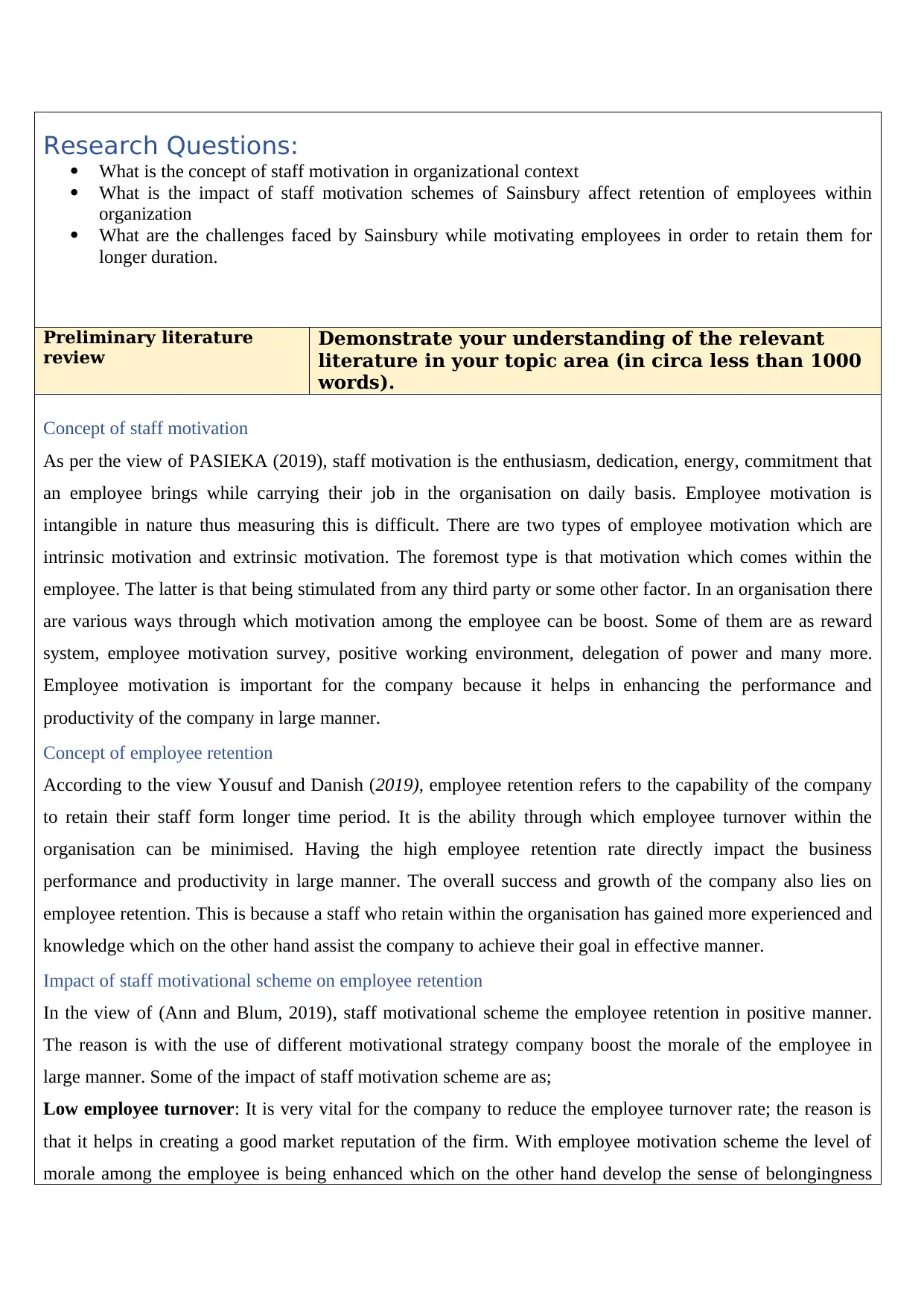
Research Questions:
What is the concept of staff motivation in organizational context
What is the impact of staff motivation schemes of Sainsbury affect retention of employees within
organization
What are the challenges faced by Sainsbury while motivating employees in order to retain them for
longer duration.
Preliminary literature
review
Demonstrate your understanding of the relevant
literature in your topic area (in circa less than 1000
words).
Concept of staff motivation
As per the view of PASIEKA (2019), staff motivation is the enthusiasm, dedication, energy, commitment that
an employee brings while carrying their job in the organisation on daily basis. Employee motivation is
intangible in nature thus measuring this is difficult. There are two types of employee motivation which are
intrinsic motivation and extrinsic motivation. The foremost type is that motivation which comes within the
employee. The latter is that being stimulated from any third party or some other factor. In an organisation there
are various ways through which motivation among the employee can be boost. Some of them are as reward
system, employee motivation survey, positive working environment, delegation of power and many more.
Employee motivation is important for the company because it helps in enhancing the performance and
productivity of the company in large manner.
Concept of employee retention
According to the view Yousuf and Danish (2019), employee retention refers to the capability of the company
to retain their staff form longer time period. It is the ability through which employee turnover within the
organisation can be minimised. Having the high employee retention rate directly impact the business
performance and productivity in large manner. The overall success and growth of the company also lies on
employee retention. This is because a staff who retain within the organisation has gained more experienced and
knowledge which on the other hand assist the company to achieve their goal in effective manner.
Impact of staff motivational scheme on employee retention
In the view of (Ann and Blum, 2019), staff motivational scheme the employee retention in positive manner.
The reason is with the use of different motivational strategy company boost the morale of the employee in
large manner. Some of the impact of staff motivation scheme are as;
Low employee turnover: It is very vital for the company to reduce the employee turnover rate; the reason is
that it helps in creating a good market reputation of the firm. With employee motivation scheme the level of
morale among the employee is being enhanced which on the other hand develop the sense of belongingness
What is the concept of staff motivation in organizational context
What is the impact of staff motivation schemes of Sainsbury affect retention of employees within
organization
What are the challenges faced by Sainsbury while motivating employees in order to retain them for
longer duration.
Preliminary literature
review
Demonstrate your understanding of the relevant
literature in your topic area (in circa less than 1000
words).
Concept of staff motivation
As per the view of PASIEKA (2019), staff motivation is the enthusiasm, dedication, energy, commitment that
an employee brings while carrying their job in the organisation on daily basis. Employee motivation is
intangible in nature thus measuring this is difficult. There are two types of employee motivation which are
intrinsic motivation and extrinsic motivation. The foremost type is that motivation which comes within the
employee. The latter is that being stimulated from any third party or some other factor. In an organisation there
are various ways through which motivation among the employee can be boost. Some of them are as reward
system, employee motivation survey, positive working environment, delegation of power and many more.
Employee motivation is important for the company because it helps in enhancing the performance and
productivity of the company in large manner.
Concept of employee retention
According to the view Yousuf and Danish (2019), employee retention refers to the capability of the company
to retain their staff form longer time period. It is the ability through which employee turnover within the
organisation can be minimised. Having the high employee retention rate directly impact the business
performance and productivity in large manner. The overall success and growth of the company also lies on
employee retention. This is because a staff who retain within the organisation has gained more experienced and
knowledge which on the other hand assist the company to achieve their goal in effective manner.
Impact of staff motivational scheme on employee retention
In the view of (Ann and Blum, 2019), staff motivational scheme the employee retention in positive manner.
The reason is with the use of different motivational strategy company boost the morale of the employee in
large manner. Some of the impact of staff motivation scheme are as;
Low employee turnover: It is very vital for the company to reduce the employee turnover rate; the reason is
that it helps in creating a good market reputation of the firm. With employee motivation scheme the level of
morale among the employee is being enhanced which on the other hand develop the sense of belongingness
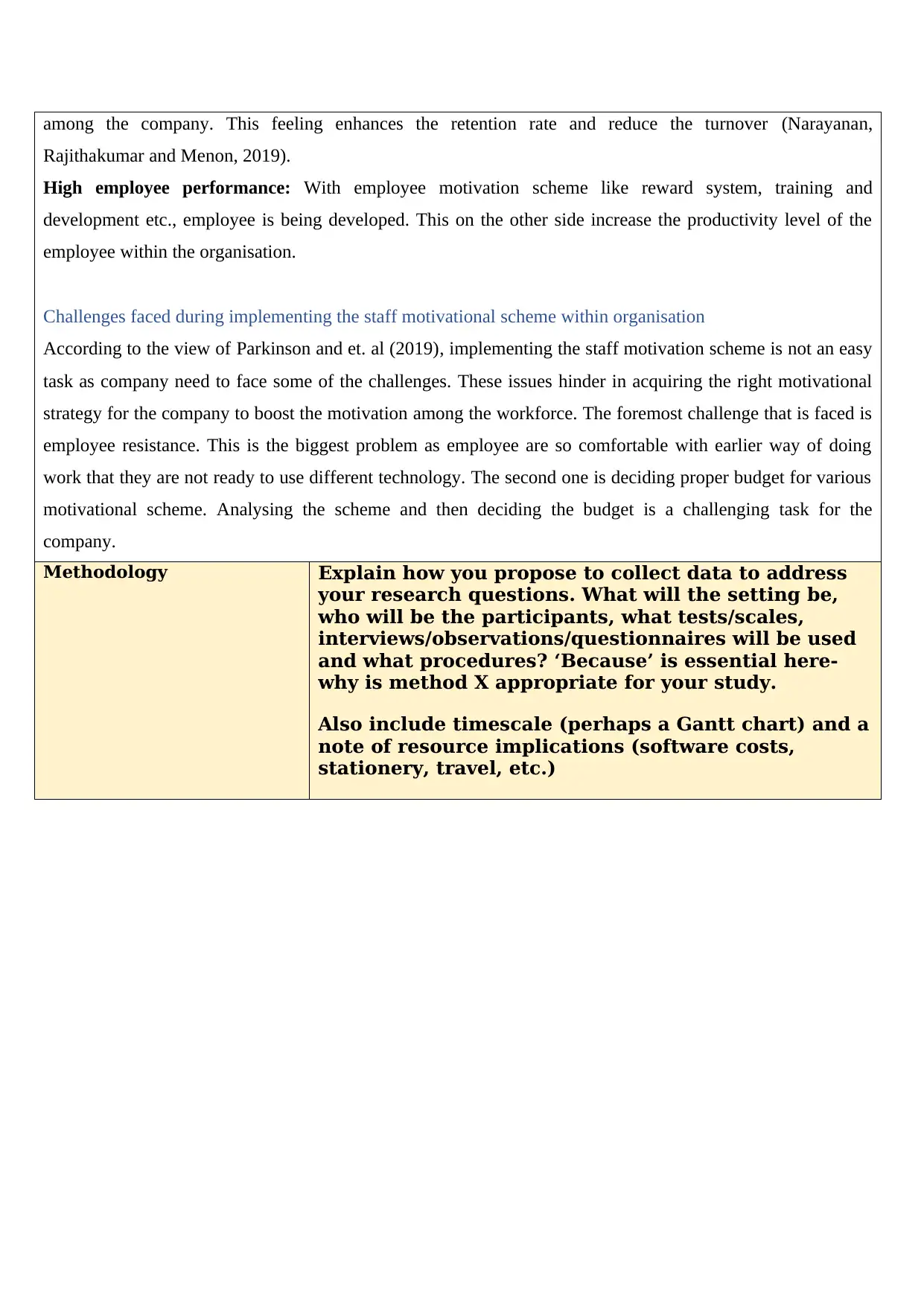
among the company. This feeling enhances the retention rate and reduce the turnover (Narayanan,
Rajithakumar and Menon, 2019).
High employee performance: With employee motivation scheme like reward system, training and
development etc., employee is being developed. This on the other side increase the productivity level of the
employee within the organisation.
Challenges faced during implementing the staff motivational scheme within organisation
According to the view of Parkinson and et. al (2019), implementing the staff motivation scheme is not an easy
task as company need to face some of the challenges. These issues hinder in acquiring the right motivational
strategy for the company to boost the motivation among the workforce. The foremost challenge that is faced is
employee resistance. This is the biggest problem as employee are so comfortable with earlier way of doing
work that they are not ready to use different technology. The second one is deciding proper budget for various
motivational scheme. Analysing the scheme and then deciding the budget is a challenging task for the
company.
Methodology Explain how you propose to collect data to address
your research questions. What will the setting be,
who will be the participants, what tests/scales,
interviews/observations/questionnaires will be used
and what procedures? ‘Because’ is essential here-
why is method X appropriate for your study.
Also include timescale (perhaps a Gantt chart) and a
note of resource implications (software costs,
stationery, travel, etc.)
Rajithakumar and Menon, 2019).
High employee performance: With employee motivation scheme like reward system, training and
development etc., employee is being developed. This on the other side increase the productivity level of the
employee within the organisation.
Challenges faced during implementing the staff motivational scheme within organisation
According to the view of Parkinson and et. al (2019), implementing the staff motivation scheme is not an easy
task as company need to face some of the challenges. These issues hinder in acquiring the right motivational
strategy for the company to boost the motivation among the workforce. The foremost challenge that is faced is
employee resistance. This is the biggest problem as employee are so comfortable with earlier way of doing
work that they are not ready to use different technology. The second one is deciding proper budget for various
motivational scheme. Analysing the scheme and then deciding the budget is a challenging task for the
company.
Methodology Explain how you propose to collect data to address
your research questions. What will the setting be,
who will be the participants, what tests/scales,
interviews/observations/questionnaires will be used
and what procedures? ‘Because’ is essential here-
why is method X appropriate for your study.
Also include timescale (perhaps a Gantt chart) and a
note of resource implications (software costs,
stationery, travel, etc.)
Paraphrase This Document
Need a fresh take? Get an instant paraphrase of this document with our AI Paraphraser

Research methodology
It is systematic process to identify, analyse and interpret the data for the research. With the use of
methodology, a proper approach, philosophy, and choice is made to collect and analyse right type of data for
the study (Staron, 2020).
Research choice: There are three types of research choice that are quantitative, qualitative, and mixed research
method. It depends upon the researcher that from all which method they will used for conducting their
investigation in appropriate way. To carry the present research, researcher would be selecting quantitative
research method (Gupta and Gupta, 2022). The main advantage to use this is that the data will be gathered in
the form of number, figures, and value. This type of data will show the valid result for the study.
Research philosophy: It is that stage where a set of belief about the phenomenon is decided to gather and
analyse data for the investigation. Positivism, interpretivism and realism are the three roots of research
philosophy. As per the investigation, positivism philosophy will be selecting by the investigator. The reason
for this is that it would gather data in objective manner that will help in understanding the social world in more
reliable manner (Mukherjee, 2019).
Time horizon: This is the time framework that helps in knowing the investing time for the study. There are
two branches for time horizon that are cross sectional and longitudinal. According to the chosen topic,
investigator will be opting cross sectional time horizon. The reason is that with the use of this less time will be
invest to gather and complete the overall investigation (Rodrigues and Rosa, 2019).
Research approach: It is that layer in the methodology which focuses on choosing the right approach to
address the research problem. To address the problem hypothesis and theories are being tested. Deductive and
inductive are the two research approaches. In the present investigation, investigator will be choosing deductive
research approach. The reason is that it will address the problem with the help of numerical information
(Singh, 2022).
Research strategy
Research strategy is that layer that is used to gather data for the research. Survey, experimental research, case
study, grounded theory and many more are some types of research strategy. As per the current research,
researcher will be selecting survey research strategy. This is because it will gather volume quantitative data in
lesser time and cost (Wohlin and Runeson, 2021).
Sampling technique
Probability and non-probability are the two sampling techniques through which sample population is being
taken out. As per the present investigation, investigator will be selecting probability sampling. In that also
simple random sampling method will be used (Hughes and Barlo, 2021). The main reason is that it will
provide equivalent chance to be the part of the investigation. The sample size will be 30 managers from
It is systematic process to identify, analyse and interpret the data for the research. With the use of
methodology, a proper approach, philosophy, and choice is made to collect and analyse right type of data for
the study (Staron, 2020).
Research choice: There are three types of research choice that are quantitative, qualitative, and mixed research
method. It depends upon the researcher that from all which method they will used for conducting their
investigation in appropriate way. To carry the present research, researcher would be selecting quantitative
research method (Gupta and Gupta, 2022). The main advantage to use this is that the data will be gathered in
the form of number, figures, and value. This type of data will show the valid result for the study.
Research philosophy: It is that stage where a set of belief about the phenomenon is decided to gather and
analyse data for the investigation. Positivism, interpretivism and realism are the three roots of research
philosophy. As per the investigation, positivism philosophy will be selecting by the investigator. The reason
for this is that it would gather data in objective manner that will help in understanding the social world in more
reliable manner (Mukherjee, 2019).
Time horizon: This is the time framework that helps in knowing the investing time for the study. There are
two branches for time horizon that are cross sectional and longitudinal. According to the chosen topic,
investigator will be opting cross sectional time horizon. The reason is that with the use of this less time will be
invest to gather and complete the overall investigation (Rodrigues and Rosa, 2019).
Research approach: It is that layer in the methodology which focuses on choosing the right approach to
address the research problem. To address the problem hypothesis and theories are being tested. Deductive and
inductive are the two research approaches. In the present investigation, investigator will be choosing deductive
research approach. The reason is that it will address the problem with the help of numerical information
(Singh, 2022).
Research strategy
Research strategy is that layer that is used to gather data for the research. Survey, experimental research, case
study, grounded theory and many more are some types of research strategy. As per the current research,
researcher will be selecting survey research strategy. This is because it will gather volume quantitative data in
lesser time and cost (Wohlin and Runeson, 2021).
Sampling technique
Probability and non-probability are the two sampling techniques through which sample population is being
taken out. As per the present investigation, investigator will be selecting probability sampling. In that also
simple random sampling method will be used (Hughes and Barlo, 2021). The main reason is that it will
provide equivalent chance to be the part of the investigation. The sample size will be 30 managers from
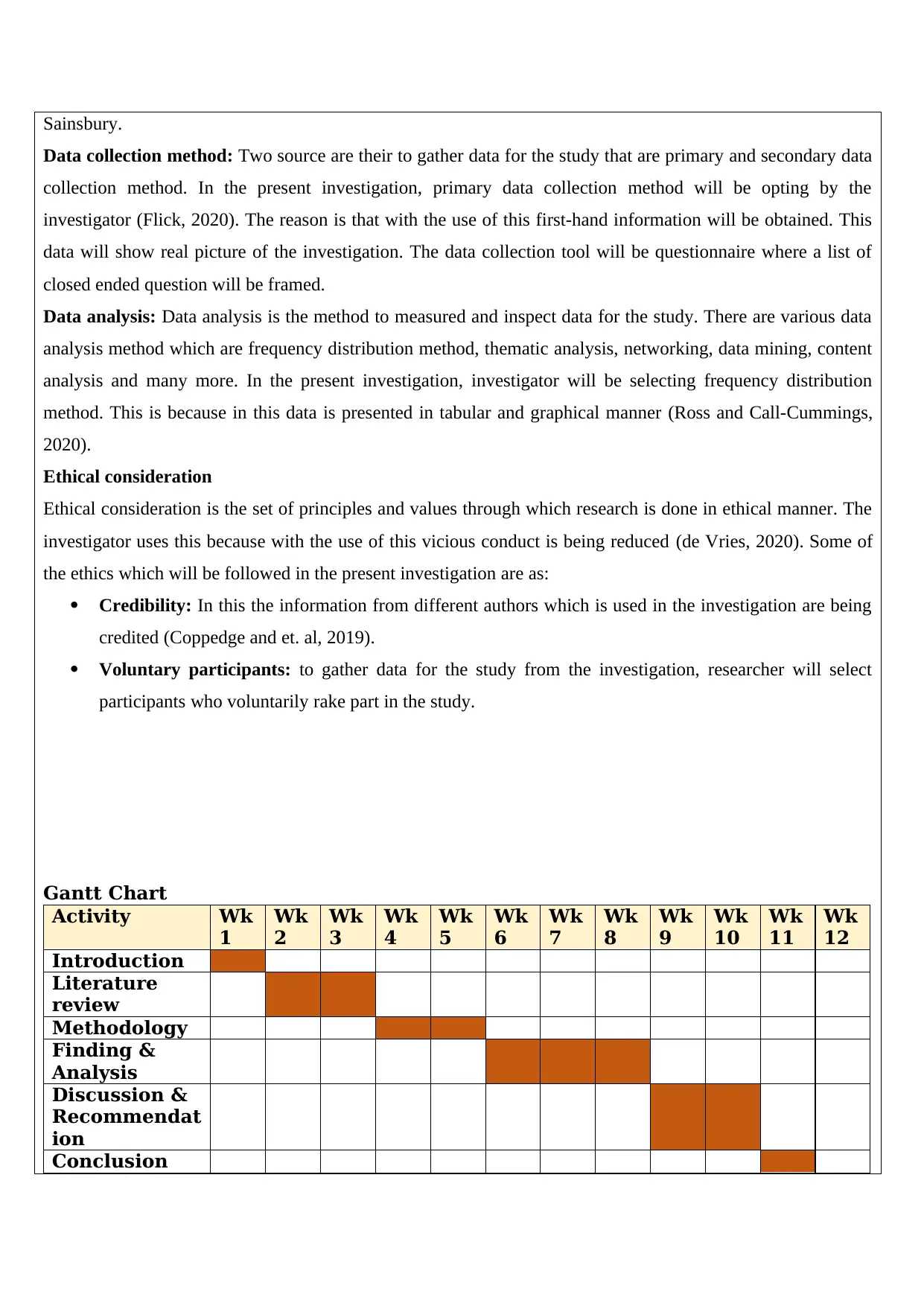
Sainsbury.
Data collection method: Two source are their to gather data for the study that are primary and secondary data
collection method. In the present investigation, primary data collection method will be opting by the
investigator (Flick, 2020). The reason is that with the use of this first-hand information will be obtained. This
data will show real picture of the investigation. The data collection tool will be questionnaire where a list of
closed ended question will be framed.
Data analysis: Data analysis is the method to measured and inspect data for the study. There are various data
analysis method which are frequency distribution method, thematic analysis, networking, data mining, content
analysis and many more. In the present investigation, investigator will be selecting frequency distribution
method. This is because in this data is presented in tabular and graphical manner (Ross and Call-Cummings,
2020).
Ethical consideration
Ethical consideration is the set of principles and values through which research is done in ethical manner. The
investigator uses this because with the use of this vicious conduct is being reduced (de Vries, 2020). Some of
the ethics which will be followed in the present investigation are as:
Credibility: In this the information from different authors which is used in the investigation are being
credited (Coppedge and et. al, 2019).
Voluntary participants: to gather data for the study from the investigation, researcher will select
participants who voluntarily rake part in the study.
Gantt Chart
Activity Wk
1
Wk
2
Wk
3
Wk
4
Wk
5
Wk
6
Wk
7
Wk
8
Wk
9
Wk
10
Wk
11
Wk
12
Introduction
Literature
review
Methodology
Finding &
Analysis
Discussion &
Recommendat
ion
Conclusion
Data collection method: Two source are their to gather data for the study that are primary and secondary data
collection method. In the present investigation, primary data collection method will be opting by the
investigator (Flick, 2020). The reason is that with the use of this first-hand information will be obtained. This
data will show real picture of the investigation. The data collection tool will be questionnaire where a list of
closed ended question will be framed.
Data analysis: Data analysis is the method to measured and inspect data for the study. There are various data
analysis method which are frequency distribution method, thematic analysis, networking, data mining, content
analysis and many more. In the present investigation, investigator will be selecting frequency distribution
method. This is because in this data is presented in tabular and graphical manner (Ross and Call-Cummings,
2020).
Ethical consideration
Ethical consideration is the set of principles and values through which research is done in ethical manner. The
investigator uses this because with the use of this vicious conduct is being reduced (de Vries, 2020). Some of
the ethics which will be followed in the present investigation are as:
Credibility: In this the information from different authors which is used in the investigation are being
credited (Coppedge and et. al, 2019).
Voluntary participants: to gather data for the study from the investigation, researcher will select
participants who voluntarily rake part in the study.
Gantt Chart
Activity Wk
1
Wk
2
Wk
3
Wk
4
Wk
5
Wk
6
Wk
7
Wk
8
Wk
9
Wk
10
Wk
11
Wk
12
Introduction
Literature
review
Methodology
Finding &
Analysis
Discussion &
Recommendat
ion
Conclusion

Personal
Reflection
Notes Of Resources Implications:
List of references Like your in-text references, these should be
immaculately formatted to score all of those easy-to-
get marks.
Books and journal
Skelton, A.R., Nattress, D. and Dwyer, R.J., 2019. Predicting
manufacturing employee turnover intentions. Journal of
Economics, Finance and Administrative Science.
Hom, P.W., Allen, D.G. and Griffeth, R.W., 2019. Employee retention
and turnover: Why employees stay or leave. Routledge.
Kim, J.S., Milliman, J. and Lucas, A., 2020. Effects of CSR on employee
retention via identification and quality-of-work-life. International
Journal of Contemporary Hospitality Management. 32(3).
pp.1163-1179.
Li, J.J., Bonn, M.A. and Ye, B.H., 2019. Hotel employee's artificial
intelligence and robotics awareness and its impact on turnover
intention: The moderating roles of perceived organizational
support and competitive psychological climate. Tourism
Management. 73. pp.172-181.
Wen, B., and et. al, 2020. Role stress and turnover intention of front-line
hotel employees: the roles of burnout and service
climate. Frontiers in Psychology. 11. p.36.
PASIEKA, S., 2019. METHODOLOGY ASPECTS OF THE PERSONE
MOTIVATION FORMATION IN THE HOTEL AND
RESTAURANT BUSINESS AND TOURISM. Bulletin of the
Cherkasy Bohdan Khmelnytsky National University. Economic
Sciences, (3).
Narayanan, A., Rajithakumar, S. and Menon, M., 2019. Talent
management and employee retention: An integrative research
framework. Human Resource Development Review. 18(2). pp.228-
247.
Yousuf, Shahtaj, and Danish Ahmed Siddiqui. "Factors influencing
employee retention: A Karachi based comparative study on IT and
banking industry." Yousuf, S. and Siddiqui, DA (2019). Factors
Influencing Employee Retention: A Karachi Based Comparative
Study on IT and Banking Industry. International Journal of
Human Resource Studies 9, no. 1 (2019): 42-62.
Ann, S. and Blum, S.C., 2019. Motivating senior employees in the
hospitality industry. International Journal of Contemporary
Hospitality Management.
Parkinson, B., and et. al, 2019. Designing and using incentives to support
Reflection
Notes Of Resources Implications:
List of references Like your in-text references, these should be
immaculately formatted to score all of those easy-to-
get marks.
Books and journal
Skelton, A.R., Nattress, D. and Dwyer, R.J., 2019. Predicting
manufacturing employee turnover intentions. Journal of
Economics, Finance and Administrative Science.
Hom, P.W., Allen, D.G. and Griffeth, R.W., 2019. Employee retention
and turnover: Why employees stay or leave. Routledge.
Kim, J.S., Milliman, J. and Lucas, A., 2020. Effects of CSR on employee
retention via identification and quality-of-work-life. International
Journal of Contemporary Hospitality Management. 32(3).
pp.1163-1179.
Li, J.J., Bonn, M.A. and Ye, B.H., 2019. Hotel employee's artificial
intelligence and robotics awareness and its impact on turnover
intention: The moderating roles of perceived organizational
support and competitive psychological climate. Tourism
Management. 73. pp.172-181.
Wen, B., and et. al, 2020. Role stress and turnover intention of front-line
hotel employees: the roles of burnout and service
climate. Frontiers in Psychology. 11. p.36.
PASIEKA, S., 2019. METHODOLOGY ASPECTS OF THE PERSONE
MOTIVATION FORMATION IN THE HOTEL AND
RESTAURANT BUSINESS AND TOURISM. Bulletin of the
Cherkasy Bohdan Khmelnytsky National University. Economic
Sciences, (3).
Narayanan, A., Rajithakumar, S. and Menon, M., 2019. Talent
management and employee retention: An integrative research
framework. Human Resource Development Review. 18(2). pp.228-
247.
Yousuf, Shahtaj, and Danish Ahmed Siddiqui. "Factors influencing
employee retention: A Karachi based comparative study on IT and
banking industry." Yousuf, S. and Siddiqui, DA (2019). Factors
Influencing Employee Retention: A Karachi Based Comparative
Study on IT and Banking Industry. International Journal of
Human Resource Studies 9, no. 1 (2019): 42-62.
Ann, S. and Blum, S.C., 2019. Motivating senior employees in the
hospitality industry. International Journal of Contemporary
Hospitality Management.
Parkinson, B., and et. al, 2019. Designing and using incentives to support
Secure Best Marks with AI Grader
Need help grading? Try our AI Grader for instant feedback on your assignments.
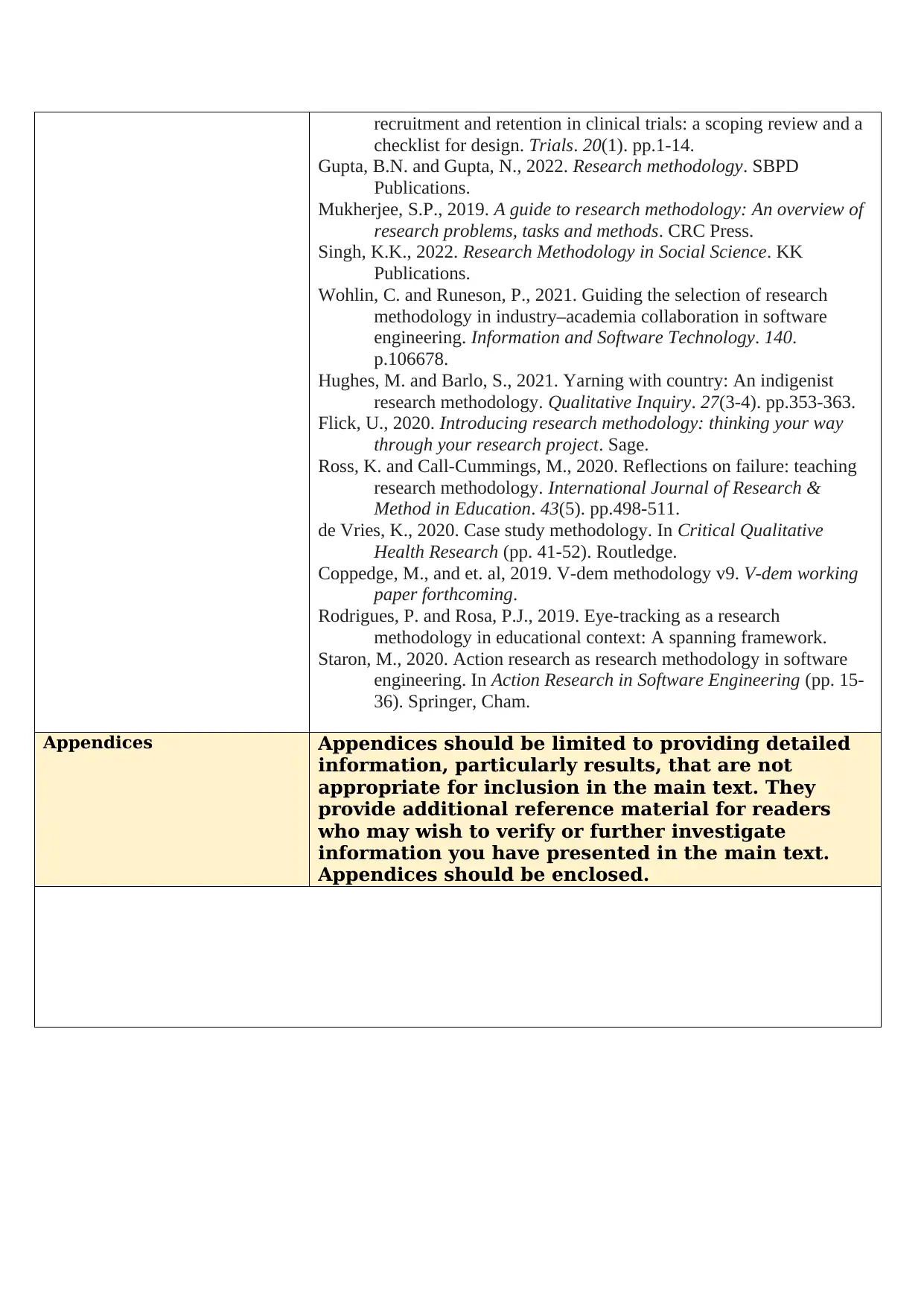
recruitment and retention in clinical trials: a scoping review and a
checklist for design. Trials. 20(1). pp.1-14.
Gupta, B.N. and Gupta, N., 2022. Research methodology. SBPD
Publications.
Mukherjee, S.P., 2019. A guide to research methodology: An overview of
research problems, tasks and methods. CRC Press.
Singh, K.K., 2022. Research Methodology in Social Science. KK
Publications.
Wohlin, C. and Runeson, P., 2021. Guiding the selection of research
methodology in industry–academia collaboration in software
engineering. Information and Software Technology. 140.
p.106678.
Hughes, M. and Barlo, S., 2021. Yarning with country: An indigenist
research methodology. Qualitative Inquiry. 27(3-4). pp.353-363.
Flick, U., 2020. Introducing research methodology: thinking your way
through your research project. Sage.
Ross, K. and Call-Cummings, M., 2020. Reflections on failure: teaching
research methodology. International Journal of Research &
Method in Education. 43(5). pp.498-511.
de Vries, K., 2020. Case study methodology. In Critical Qualitative
Health Research (pp. 41-52). Routledge.
Coppedge, M., and et. al, 2019. V-dem methodology v9. V-dem working
paper forthcoming.
Rodrigues, P. and Rosa, P.J., 2019. Eye-tracking as a research
methodology in educational context: A spanning framework.
Staron, M., 2020. Action research as research methodology in software
engineering. In Action Research in Software Engineering (pp. 15-
36). Springer, Cham.
Appendices Appendices should be limited to providing detailed
information, particularly results, that are not
appropriate for inclusion in the main text. They
provide additional reference material for readers
who may wish to verify or further investigate
information you have presented in the main text.
Appendices should be enclosed.
checklist for design. Trials. 20(1). pp.1-14.
Gupta, B.N. and Gupta, N., 2022. Research methodology. SBPD
Publications.
Mukherjee, S.P., 2019. A guide to research methodology: An overview of
research problems, tasks and methods. CRC Press.
Singh, K.K., 2022. Research Methodology in Social Science. KK
Publications.
Wohlin, C. and Runeson, P., 2021. Guiding the selection of research
methodology in industry–academia collaboration in software
engineering. Information and Software Technology. 140.
p.106678.
Hughes, M. and Barlo, S., 2021. Yarning with country: An indigenist
research methodology. Qualitative Inquiry. 27(3-4). pp.353-363.
Flick, U., 2020. Introducing research methodology: thinking your way
through your research project. Sage.
Ross, K. and Call-Cummings, M., 2020. Reflections on failure: teaching
research methodology. International Journal of Research &
Method in Education. 43(5). pp.498-511.
de Vries, K., 2020. Case study methodology. In Critical Qualitative
Health Research (pp. 41-52). Routledge.
Coppedge, M., and et. al, 2019. V-dem methodology v9. V-dem working
paper forthcoming.
Rodrigues, P. and Rosa, P.J., 2019. Eye-tracking as a research
methodology in educational context: A spanning framework.
Staron, M., 2020. Action research as research methodology in software
engineering. In Action Research in Software Engineering (pp. 15-
36). Springer, Cham.
Appendices Appendices should be limited to providing detailed
information, particularly results, that are not
appropriate for inclusion in the main text. They
provide additional reference material for readers
who may wish to verify or further investigate
information you have presented in the main text.
Appendices should be enclosed.
1 out of 11
Related Documents
Your All-in-One AI-Powered Toolkit for Academic Success.
+13062052269
info@desklib.com
Available 24*7 on WhatsApp / Email
![[object Object]](/_next/static/media/star-bottom.7253800d.svg)
Unlock your academic potential
© 2024 | Zucol Services PVT LTD | All rights reserved.



